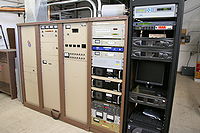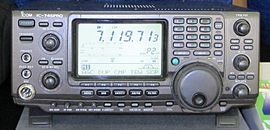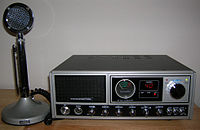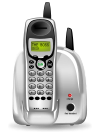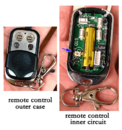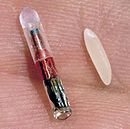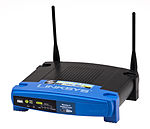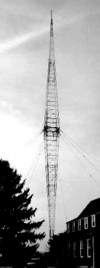- Transmitter
-
For biologic transmitters, see transmitter substance.
 Commercial FM broadcasting transmitter at radio station WDET-FM, Wayne State University, Detroit, USA. It broadcasts at 101.9 MHz with a radiated power of 48 kW.
Commercial FM broadcasting transmitter at radio station WDET-FM, Wayne State University, Detroit, USA. It broadcasts at 101.9 MHz with a radiated power of 48 kW.
In electronics and telecommunications a transmitter or radio transmitter is an electronic device which, with the aid of an antenna, produces radio waves. The transmitter itself generates a radio frequency alternating current, which is applied to the antenna. When excited by this alternating current, the antenna radiates radio waves. In addition to their use in broadcasting, transmitters are necessary component parts of many electronic devices that communicate by radio, such as cell phones, wireless computer networks, Bluetooth enabled devices, garage door openers, two-way radios in aircraft, ships, and spacecraft, radar sets, and navigational beacons. The term transmitter is usually limited to equipment that generates radio waves for communication purposes; or radiolocation, such as radar and navigational transmitters. Generators of radio waves for heating or industrial purposes, such as microwave ovens or diathermy equipment, are not usually called transmitters even though they often have similar circuits.
The term is popularly used more specifically to refer to transmitting equipment used for broadcasting, as in radio transmitter or television transmitter. This usage usually includes both the transmitter proper as described above, and the antenna, and often the building it is housed in.
An unrelated use of the term is in industrial process control, where a "transmitter" is a telemetry device which converts measurements from a sensor into a signal, and sends it, usually via wires, to be received by some display or control device located a distance away.
Contents
Description
A transmitter can be a separate piece of electronic equipment, or an electrical circuit within another electronic device. A transmitter and receiver combined in one unit is called a transceiver. The term transmitter is often abbreviated "XMTR" or "TX" in technical documents. The purpose of most transmitters is radio communication of information over a distance. The information is provided to the transmitter in the form of an electronic signal, such as an audio (sound) signal from a microphone, a video (TV) signal from a TV camera, or in wireless networking devices a digital signal from a computer. The transmitter combines the information signal to be carried with the radio frequency signal which generates the radio waves, which is often called the carrier. This process is called modulation. The information can be added to the carrier in several different ways, in different types of transmitter. In an amplitude modulation (AM) transmitter, the information is added to the radio signal by varying its amplitude (strength). In a frequency modulation (FM) transmitter, it is added by varying the radio signal's frequency slightly. Many other types of modulation are used.
Radio transmitters
Continental 816R-5B 35 kilowatt FM transmitter, belonging to American FM radio station KWNR broadcasting on 95.5 MHz in Las Vegas.Modern amateur radio transceiver, the ICOM IC-746PRO. It can transmit on the amateur bands from 1.8 MHz to 144 MHz with an output power of 100 W.A CB radio transceiver, a two way radio transmitting on 27 MHz with a power of 4 watts, that can be operated without a licenseConsumer products that contain transmitters
A cordless phone. Both the handset and the base contain low power 2.4 GHz radio transmitters to communicate with each otherA garage door opener control contains a low-power 2.4 GHz transmitter that sends coded commands to the garage door mechanism to open or close.An RFID chip (next to rice grain) contains a tiny transmitter that transmits an identification number. They are incorporated into consumer products, and even implanted in pets.In a wireless computer network, wireless routers like this contain a 5.8 GHz transmitter that sends downloaded web pages and email to local computers.Legal restrictions
In most parts of the world, use of transmitters is strictly controlled by law because of the potential for dangerous interference with other radio transmissions (for example to emergency communications). Transmitters must be licensed by governments, under a variety of license classes depending on use: (broadcast, marine radio, Airband, Amateur etc.), and are restricted to certain frequencies and power levels. In some classes each transmitter is given a unique call sign consisting of a string of letters and numbers which must be used as an identifier in transmissions. The operator of the transmitter usually must hold a government license, such as a general radiotelephone operator license, which is obtained by passing a test demonstrating adequate technical and legal knowledge of safe radio operation.
An exception is made allowing the unlicensed use of low-power short-range transmitters in devices such as wireless microphones, cordless telephones, walkie-talkies, Wifi and Bluetooth, garage door openers, and baby monitors. In the US, these fall under Part 15 of the Federal Communications Commission (FCC) regulations. Although they can be operated without a license, these devices still generally must be type-approved before sale.
How it works
A radio transmitter is an electronic circuit which transforms electric power from a battery or electrical mains into a radio frequency alternating current, which reverses direction millions to billions of times per second. The energy in such a rapidly-reversing current can radiate off a conductor (the antenna) as electromagnetic waves (radio waves). The transmitter also "piggybacks" information, such as an audio or video signal, onto the radio frequency current to be carried by the radio waves. When they strike the antenna of a radio receiver, the waves excite similar (but less powerful) radio frequency currents in it. The radio receiver extracts the information from the received waves. A practical radio transmitter usually consists of these parts:
- A power supply circuit to transform the input electrical power to the higher voltages needed to produce the required power output.
- An electronic oscillator circuit to generate the radio frequency signal. This usually generates a sine wave of constant amplitude often called the carrier wave. In most modern transmitters this is a crystal oscillator in which the frequency is precisely controlled by the vibrations of a quartz crystal.
- A modulator circuit to add the information to be transmitted to the carrier wave produced by the oscillator. This is done by varying some aspect of the carrier wave. The information is provided to the transmitter either in the form of an audio signal, which represents sound, a video signal, or for data in the form of a binary digital signal.
- In an AM (amplitude modulation) transmitter the amplitude (strength) of the carrier wave is varied in proportion to the audio signal.
- In an FM (frequency modulation) transmitter the frequency of the carrier is varied by the audio signal.
- In an FSK (frequency-shift keying) transmitter, which transmits digital data, the frequency of the carrier is shifted between two frequencies which represent the two binary digits, 0 and 1.
- Many other types of modulation are also used. In large transmitters the oscillator and modulator together are often referred to as the exciter.
- An RF power amplifier to increase the power of the signal, to increase the range of the radio waves.
- An impedance matching (antenna tuner) circuit to match the impedance of the transmitter to the impedance of the antenna (or the transmission line to the antenna), to transfer power efficiently to the antenna. If these impedances are not equal, it causes a condition called standing waves, in which the power is reflected back from the antenna toward the transmitter, wasting power and sometimes overheating the transmitter.
In higher frequency transmitters, in the UHF and microwave range, oscillators that operate stably at the output frequency cannot be built. In these transmitters the oscillator usually operates at a lower frequency, and is multiplied by frequency multipliers to get a signal at the desired frequency.
History
The first primitive radio transmitters (called Hertzian oscillators) were built by German physicist Heinrich Hertz in 1887 during his pioneering investigations of radio waves. These generated radio waves by a high voltage spark between two conductors. These spark-gap transmitters were used during the first three decades of radio (1887-1917), called the wireless telegraphy era. Short-lived competing techniques came into use after the turn of the century, such as the Alexanderson alternator and Poulsen Arc transmitters. But all these early technologies were replaced by vacuum tube transmitters in the 1920s, because they were inexpensive and produced continuous waves, which could be modulated to transmit audio (sound) using amplitude modulation (AM) and frequency modulation (FM). This made possible commercial radio broadcasting, which began about 1920. The development of radar before and during World War 2 was a great stimulus to the evolution of high frequency transmitters in the UHF and microwave ranges, using new devices such as the magnetron and traveling wave tube. In recent years, the need to conserve crowded radio spectrum bandwidth has driven the development of new types of transmitters such as spread spectrum.
Broadcast transmitters
Frequency Control
Power output
In broadcasting and telecommunication, the part which contains the oscillator, modulator, and sometimes audio processor, is called the "exciter". Most transmitters use heterodyne principle, so they also have a frequency conversion units. Confusingly, the high-power amplifier which the exciter then feeds into is often called the "transmitter" by broadcast engineers. The final output is given as transmitter power output (TPO), although this is not what most stations are rated by.
Effective radiated power (ERP) is used when calculating station coverage, even for most non-broadcast stations. It is the TPO, minus any attenuation or radiated loss in the line to the antenna, multiplied by the gain (magnification) which the antenna provides toward the horizon. This antenna gain is important, because achieving a desired signal strength without it would result in an enormous electric utility bill for the transmitter, and a prohibitively expensive transmitter. For most large stations in the VHF- and UHF-range, the transmitter power is no more than 20% of the ERP.
For VLF, LF, MF and HF the ERP is typically not determined separately. In most cases the transmission power found in lists of transmitters is the value for the output of the transmitter. This is only correct for omnidirectional aerials with a length of a quarter wavelength or shorter. For other aerial types there are gain factors, which can reach values until 50 for shortwave directional beams in the direction of maximum beam intensity.
Since some authors take account of gain factors of aerials of transmitters for frequencies below 30 MHz and others not, there are often discrepancies of the values of transmitted powers.
Power supply
Transmitters are sometimes fed from a higher voltage level of the power supply grid than necessary in order to improve security of supply. For example, the Allouis, Konstantynow and Roumoules transmitters are fed from the high-voltage network (110 kV in Alouis and Konstantynow, 150 kV in Roumoules) even though a power supply from the medium-voltage level of the power grid (about 20 kV) would be able to deliver enough power. [1][2]
Cooling of final stages
Low-power transmitters do not require special cooling equipment. Modern transmitters can be incredibly efficient, with efficiencies exceeding 98 percent. However, a broadcast transmitter with a megawatt power stage transferring 98% of that into the antenna can also be viewed as a 20 kilowatt electric heater.
For medium-power transmitters, up to a few hundred watts, air cooling with fans is used. At power levels over a few kilowatts, the output stage is cooled by a forced liquid cooling system analogous to an automobile cooling system. Since the coolant directly touches the high-voltage anodes of the tubes, only distilled, deionised water or a special dielectric coolant can be used in the cooling circuit. This high-purity coolant is in turn cooled by a heat exchanger, where the second cooling circuit can use water of ordinary quality because it is not in contact with energized parts. Very-high-power tubes of small physical size may use evaporative cooling by water in contact with the anode. The production of steam allows a high heat flow in a small space.
Protection equipment
The high voltages used in high power transmitters (up to 40 kV) require extensive protection equipment. Also, transmitters are exposed to damage from lightning. Transmitters may be damaged if operated without an antenna, so protection circuits must detect the loss of the antenna and switch off the transmitter immediately. Tube-based transmitters must have power applied in the proper sequence, with the filament voltage applied before the anode voltage, otherwise the tubes can be damaged. The output stage must be monitored for standing waves, which indicate that generated power is not being radiated but instead is being reflected back into the transmitter.
Lightning protection is required between the transmitter and antenna. This consists of spark gaps and gas-filled surge arresters to limit the voltage that appears on the transmitter terminals. The control instrument that measures the voltage standing-wave ratio switches the transmitter off briefly if a higher voltage standing-wave ratio is detected after a lightning strike, as the reflections are probably due to lightning damage. If this does not succeed after several attempts, the antenna may be damaged and the transmitter should remain switched off. In some transmitting plants UV detectors are fitted in critical places, to switch off the transmitter if an arc is detected. The operating voltages, modulation factor, frequency and other transmitter parameters are monitored for protection and diagnostic purposes, and may be displayed locally and/or at a remote control room.
Building
A commercial transmitter site will usually have a control building to shelter the transmitter components and control devices. This is usually a purely functional building, which may contain apparatus for both radio and television transmitters. To reduce transmission line loss the transmitter building is usually immediately adjacent to the antenna for VHF and UHF sites, but for lower frequencies it may be desirable to have a distance of a few score or several hundred metres between the building and the antenna. Some transmitting towers have enclosures built into the tower to house radio relay link transmitters or other, relatively low-power transmitters. A few transmitter buildings may include limited broadcasting facilities to allow a station to use the building as a backup studio in case of incapacitation of the main facility.
Legal and regulatory aspects
Since radio waves go over borders, international agreements control radio transmissions. In European countries like Germany often the national Post Office is the regulating authority. In the United States broadcast and industrial transmitters are regulated by the Federal Communications Commission (FCC). In Canada technical aspects of broadcast and radio transmitters are controlled by Industry Canada, but broadcast content is regulated separately by the Canadian Radio-television and Telecommunications Commission (CRTC). In Australia transmitters, spectrum, and content are controlled by the Australian Communications and Media Authority (ACMA). The International Telecommunication Union (ITU) helps managing the radio-frequency spectrum internationally.
Planning
As in any costly project, the planning of a high power transmitter site requires great care. This begins with the location. A minimum distance, which depends on the transmitter frequency, transmitter power, and the design of the transmitting antennas, is required to protect people from the radio frequency energy. Antenna towers are often very tall and therefore flight paths must be evaluated. Sufficient electric power must be available for high power transmitters. Transmitters for long and medium wave require good grounding and soil of high electrical conductivity. Locations at the sea or in river valleys are ideal, but the flood danger must be considered. Transmitters for UHF are best on high mountains to improve the range (see radio propagation). The antenna pattern must be considered because it is costly to change the pattern of a long-wave or medium-wave antenna.
Transmitting antennas for long and medium wave are usually implemented as a mast radiator. Similar antennas with smaller dimensions are used also for short wave transmitters, if these send in the round spray enterprise. For arranging radiation at free standing steel towers fastened planar arrays are used. Radio towers for UHF and TV transmitters can be implemented in principle as grounded constructions. Towers may be steel lattice masts or reinforced concrete towers with antennas mounted at the top. Some transmitting towers for UHF have high-altitude operating rooms and/or facilities such as restaurants and observation platforms, which are accessible by elevator. Such towers are usually called TV tower. For microwaves one frequently uses parabolic antennas. These can be set up for applications of radio relay links on transmitting towers for FM to special platforms. For example, large parabolic antennas ranging from 3 to 100 meters in diameter are necessary to pass on signals to television satellites and space vehicles. These plants, which can be used if necessary also as radio telescope, are established on free standing constructions, whereby there are also numerous special designs, like the radio telescope in Arecibo.
Just as important as the planning of the construction and location of the transmitter is how its output fits in with existing transmissions. Two transmitters cannot broadcast on the same frequency in the same area as this would cause co-channel interference. For a good example of how the channel planners have dovetailed different transmitters' outputs see Crystal Palace UHF TV channel allocations. This reference also provides a good example of a grouped transmitter, in this case an A group. That is, all of its output is within the bottom third of the UK UHF television broadcast band. The other two groups (B and C/D) utilise the middle and top third of the band, see graph. By replicating this grouping across the country (using different groups for adjacent transmitters), co-channel interference can be minimised, and in addition, those in marginal reception areas can use more efficient grouped receiving antennas. Unfortunately, in the UK, this carefully planned system has had to be compromised with the advent of digital broadcasting which (during the changeover period at least) requires yet more channel space, and consequently the additional digital broadcast channels cannot always be fitted within the transmitter's existing group. Thus many UK transmitters have become "wideband" with the consequent need for replacement of receiving antennas (see external links). Once the Digital Switch Over (DSO) occurs the plan is that most transmitters will revert to their original groups, source Ofcom July 2007 .
Further complication arises when adjacent transmitters have to transmit on the same frequency and under these circumstances the broadcast radiation patterns are attenuated in the relevant direction(s). A good example of this is in the United Kingdom, where the Waltham transmitting station broadcasts at high power on the same frequencies as the Sandy Heath transmitting station's high power transmissions, with the two being only 50 miles apart. Thus Waltham's antenna array [1] does not broadcast these two channels in the direction of Sandy Heath and vice versa.
Where a particular service needs to have wide coverage, this is usually achieved by using multiple transmitters at different locations. Usually, these transmitters will operate at different frequencies to avoid interference where coverage overlaps. Examples include national broadcasting networks and cellular networks. In the latter, frequency switching is automatically done by the receiver as necessary, in the former, manual retuning is more common (though the Radio Data System is an example of automatic frequency switching in broadcast networks). Another system for extending coverage using multiple transmitters is quasi-synchronous transmission, but this is rarely used nowadays.
Main and relay (repeater) transmitters
Transmitting stations are usually either classified as main stations or relay stations (also known as repeaters, translators or sometimes "transposers".)
Main stations are defined as those that generate their own modulated output signal from a baseband (unmodulated) input. Usually main stations operate at high power and cover large areas.
Relay stations (translators) take an already modulated input signal, usually by direct reception of a parent station off the air, and simply rebroadcast it on another frequency. Usually relay stations operate at medium or low power, and are used to fill in pockets of poor reception within, or at the fringe of, the service area of a parent main station.
Note that a main station may also take its input signal directly off-air from another station, however this signal would be fully demodulated to baseband first, processed, and then remodulated for transmission.
Transmitters in culture
Some cities in Europe, like Mühlacker, Ismaning, Langenberg, Kalundborg, Hörby and Allouis became famous as sites of powerful transmitters. For example, Goliath transmitter was a VLF transmitter of the German Navy during World War II located near Kalbe an der Milde in Saxony-Anhalt, Germany. Some transmitting towers like the radio tower Berlin or the TV tower Stuttgart have become landmarks of cities. Many transmitting plants have very high radio towers that are masterpieces of engineering.
Having the tallest building in the world, the nation, the state/province/prefecture, city, etc., has often been considered something to brag about. Often, builders of high-rise buildings have used transmitter antennas to lay claim to having the tallest building. A historic example was the "tallest building" feud between the Chrysler Building and the Empire State Building in New York, New York.
Some towers have an observation deck accessible to tourists. An example is the Ostankino Tower in Moscow, which was completed in 1967 on the 50th anniversary of the October Revolution to demonstrate the technical abilities of the Soviet Union. As very tall radio towers of any construction type are prominent landmarks, requiring careful planning and construction, and high-power transmitters especially in the long- and medium-wave ranges can be received over long distances, such facilities were often mentioned in propaganda. Other examples were the Deutschlandsender Herzberg/Elster and the Warsaw Radio Mast.
KVLY-TV's tower located near Blanchard, North Dakota was the tallest artificial structure in the world when it was completed in 1963. It was surpassed in 1974 by the Warszawa radio mast, but regained its title when the latter collapsed in 1991. It was surpassed by the Burj Khalifa skyscraper in early 2009, but the KVLY-TV mast is still the tallest transmitter.
Records
- Tallest radio/television mast:
- 1974–1991: Konstantynow for 2000 kW longwave transmitter, 646.38 m (2120 ft 8 in)
- 1963–1974 and since 1991: KVLY Tower, 2,063 ft (628.8 m)
- Highest power:
- Longwave, Taldom transmitter, 2500 kW
- Medium wave, Bolshakovo transmitter, 2500 kW
- Highest transmission sites (North America):
- KMXD FM on Tushar Mountains
See also
- List of famous transmission sites
- Radio transmitter design
- Transmitter station
- TV transmitter
- Transposer
References
External links
- International Telecommunication Union
- Jim Hawkins' Radio and Broadcast Technology Page
- WCOV-TV's Transmitter Technical Website
- Major UK television transmitters including change of group information, see Transmitter Planning section.
- Details of UK digital television transmitters
- Richard Moore's Anorak Zone Photo Gallery of UK TV and Radio transmission sites
Categories:- Broadcast transmitters
- Telecommunications equipment
- Radar
Wikimedia Foundation. 2010.

